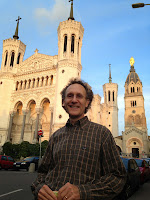We arrived into Lyon on the high speed train for a three-night stay at the Cour des Loges hotel located in the Vieux Lyon district which is narrow lanes paved with white marble and cobble stones. A perfect cloak and dagger setting. Lots of twisty streets barely one car's width. And old, founded by the Romans in 43 B.C.
The Cour des Loges was cobbled together in 1986 from four existing fourteenth-Century buildings that surround a courtyard. It is a colorful and eccentric place. Amusing to explore the all the stone spiral stairwells and akimbo passageways. Though it becomes serious to imagine the Jesuits in the seventeen-eighties who, during the French Revolution, were taken from our building and probably guillotined. The revolutionaries were keen to exterminate aristocrats and the clergy who they felt were responsible for keeping the rich rich and the poor poor.
We went to a performance at the Lyon Opera of "The Dialogue of the Carmelites" composed in the nineteen-fifties by Mr. Francis Poulenc. It tells the story of a church full of Carmelite nuns who were rounded up and guillotined during the French Revolution. Was it at "our" hotel?
The layout of Lyon is very attractive. Hilly like San Francisco, but with two rivers slicing through it. Between the rivers are spacious plazas, a large fountain by Bartholdi who built our Statue of Liberty and the grand city government buildings. There are of course a lot of bridges. And in general, most of Lyon is a pleasure stroll with allées of trees and river fronts and boulevards and hilltop vistas.
Much attention is given in travel literature to the Traboules of Lyon. These are in essence short cuts that go right through the ground floors of buildings. We visited a few. I felt awkward. These shortcuts go through residential buildings. I would not enjoy random tourists squawking in foreign languages walking through my backyard and I'm certain the Lyonnaise don't like it either.
Did we eat? Yes we did. Cream and butter and organ meats are alive and well in Lyon. We passed on the organs, but brought on the butter and cream. Our outstanding meal was in the bouchon of "Daniel et Denise". The new owner, Charles Viola, kept the old name and the old style cuisine. He's been recognized and awarded many honors, but in the end, is his food delicious? Yes, very. At our table was a salad lyonnaise of frisée lettuce, lardon (bacon chunks), bacon slices and a poached egg. I've had it many times before, this one was "the one". There was a plate of pommes dorées, thick potato slices cooked in butter till golden and crisp. And a carafe of outstanding house wine. And a plate of macaroni doused with cream and cheese. And a filet of a fish called, bar. And pork roast. And squash soup laden with cream. And île flottante for dessert. The room was filled with happy diners. There was pleasure and laughter. The table cloths were a classic red and white checked pattern. The servers were young, kind and patient. It was a wonderful meal, but probably not something one should have regularly.
We ate an excellent lunch at, Maison Villemancy, perched on the edge of a hill in a park overlooking the city and the Rhone River. We ate "Volaille fermière des Dombes à la crème parfumée à la châtaigne et riz basmati". The Dombes plateau in the northeast, and the adjacent plain of Bresse, produce the finest chickens in France, with red combs, white plumage, and blue feet, the colors of the French flag! Our chicken was, indeed, served with several inches of it's blue leg in a chestnut cream sauce.
For dessert we had the "clafoutis aux figues fraiche et glacé pain d'épices": fresh figs baked in a light egg custard batter with a scoop of anise-spice-bread ice cream in the center.
We visited the Lumiere Museum which is housed in the mansion of the Lumiere brothers. The house alone is worth the visit. It is very grand with many original carved wooden banisters, large expanses of stained glass windows, ornate floor tiles, parquet wood and a a bedroom with original furnishings. But the museum's mission is to recall the day in eighteen-ninety-five when the brothers set a camera atop a tripod and filmed the workers coming out of their factory. It is the first motion picture ever made on film stock. There are blue lights embedded in the sidewalk where the camera once stood and a large glass panel etched with the life-sized images of the workers erected where the factory gate once stood. That is the entryway to the pavilion for the Lyon Film Festival which occurred two weeks ago.
Overlooking Lyon, on a plateau, is the Croix Rousse, named for a russet color cross that was long ago placed there. That neighborhood was the center of the hive of silk manufacturing. There they would cultivate the silkworms, unravel their cocoons, feed sixty silk fibers into a machine to make thread, then weave the thread into fabric. That was in the seventeenth, eighteenth and nineteenth-Centuries. The wages were low. The conditions harsh. Silk is still created in the neighborhood, though not on the same scale. And the machines are still there. Fascinating concoctions of thousands of moving parts and hole-punched cards seeming like primitive computer technology. The machines are still standing in rooms in the buildings where they were once operated. Their complexity boggles the mind.
Lyon was a hit with us.
Paris, 2009 (photo by Roland Kato)
Paris, 2009 (photo by Roland Kato)
Sunday, October 27, 2013
Lyon, October 21-24, 2013
Subscribe to:
Post Comments (Atom)





No comments:
Post a Comment